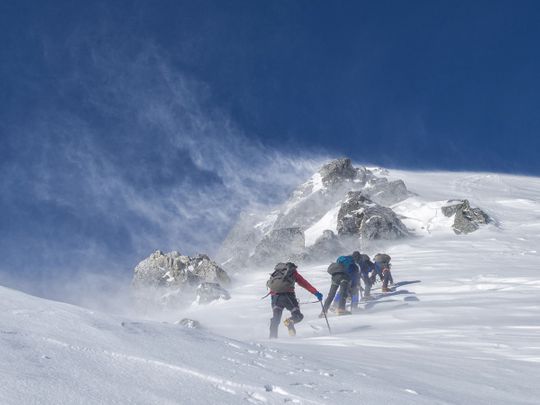
Mountains, like the ones you’ll find in today’s Word Search, are incredibly tall, majestic and deadly. They’re also the setting for some of the most unbelievable real-life stories ever told.
Click start to play today’s Word Search and spot all the peaks.
For a story of grit and incredible perseverance in the face of hopelessness, look to the Siula Grande in the Peruvian Andes – a mountain that stands tall, at 6,344m.
When 25-year-old British climber Joe Simpson became one of the first people to scale the west face of Siula Grande, he thought he was done, and he could go home happy. But his biggest challenge came on the descent, when he accidentally plunged down an ice cliff and shattered his leg.
With a storm coming in, Simpson and his climbing partner, 21-year-old Simon Yates, were forced to continue in the dark – they were separated by 45m of rope and had no way of communicating. When Simpson found himself accidentally lowered over a cliff, with no way of returning, Yates made the devastating decision (an hour later) to cut the rope, sending Simpson freefalling to certain death.
But miraculously, Simpson survived. Despite being injured and in pain, he decided to crawl all the way to base camp. Four days later, he arrived. And nearly three years after that life-changing episode, he published his best-selling book, Touching the Void, which was made into a documentary in 2003 and a play in 2018. Today, at age 61, Simpson is a successful author and motivational speaker.
Another act of heroism occurred in 1953, during the third American expedition to K2, the second-highest mountain on Earth, at 8,611m. A group of climbers were a short distance from the summit, with just 600m to go. But at about 8,000m they found themselves trapped for 10 days in a terrible storm that destroyed tents and brought on a shortage of supplies.
When one of the climbers developed thrombophlebitis – a life-threatening condition of blood clots brought on by high altitude, the team unanimously decided to abandon the summit attempt and descend. If the clots made it to the climber’s lung, he would die. So, they bundled him into a sleeping bag and braved the blizzard, by lowering him down perilous walls of rock and ice.
As they descended, they found Camp VII in sight – just 180m across an icy slope. But in a horrific turn of events, one of the climbers slipped and began to plunge down the slope. Since his rope was tied to another climber, he fell too, and then another followed, and another. Five climbers began careening down a near-vertical face of the mountain, speeding toward a 2,000m fall to the glacier below.
At the very last second, American climber Pete Schoening slammed his axe into the snow behind a boulder, and used a braking technique called a hip belay to bring the climbers to a stop. The nylon rope didn’t snap, and the hickory axe held, despite the strain of six bodies. Schoening single-handedly saved his climbing partners in what has become known as ‘The Belay’ in mountaineering history. He was later awarded the David A. Sowles Memorial Award by the American Alpine Club in 1981.
What do you think of these heroic acts? Play today’s Word Search and tell us at games@gulfnews.com.








